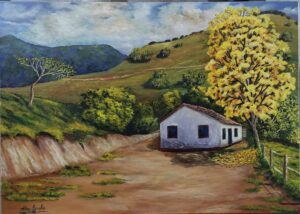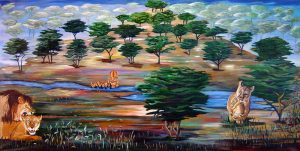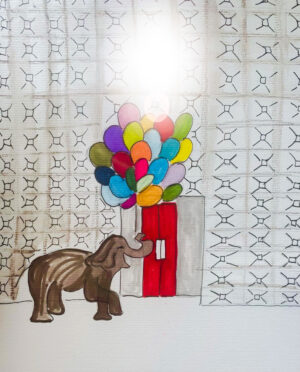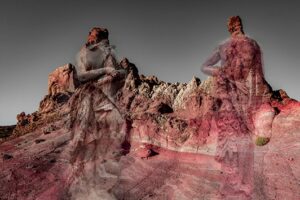7 Brazilian abstract art artists you need to know
Learn more about this artistic category and its representation in Brazil

Abstract art or abstractionism is commonly conceived as an art form (especially in the visual arts) that does not represent objects proper to our external reality. Instead, it uses the formal relationships between colours, lines and surfaces to compose the reality of the work, in a “non-representational” way.
It arises from the experiences of the European avant-gardes, which reject the Renaissance heritage of the art academies, in other words, the Greco-Roman aesthetic. The expression can also be used to refer specifically to art produced in the early 20th century by certain movements and schools that generically fit into modern art.
Before artists reached absolute abstraction, the term was also used to refer to schools such as Cubism and Futurism that, although representative and figurative, sought to synthesize elements of natural reality, resulting in works that escaped simple imitation. what was “concrete”.
Abstract Art in Brazil
In Brazil, abstract art gained strength from the I Bienal de São Paulo (1951). Among Brazilian abstract art artists, we can highlight:
1. Antônio Bandeira, 1922 – 1967, Fortaleza, Ceará



He is one of the most valued Brazilian painters and has works in the largest private collections in museums around the world. With Aldemir Martins, Inimá de Paula and others, he was part of the Modernist Movement of Fortaleza in the 1940s.
Obras em Destaque
Renowned master of abstract painting — and also of watercolors — he lived most of his life in France. He lived with the painters of the traditional École de Paris, fully integrating himself with them until his return to Brazil in 1960.
2. Ivan Serpa, 1923 – 1973, Rio de Janeiro



He was a Brazilian painter, draughtsman, teacher and engraver. Since the beginning of his career, Ivan Serpa’s work has oscillated between figurativism and concrete art. He received several awards in Brazil and participated in several biennials held in São Paulo, in addition to Venice (1952, 1954 and 1962) and Zurich (1960).
Between the late 1950s and early 1960s, his work took on new contours, starting to incorporate less determined elements such as gestures, stains and splashes of paint. In 1960, influenced by children’s drawing, he built images between abstraction and figuration.
3. Iberê Camargo, 1914 – 1994, Restinga Seca, Rio Grande do Sul



He was a Brazilian painter, printmaker and teacher; a great reference for Rio Grande do Sul and Brazilian art in general.
Although he studied with outstanding figures representing different aesthetic movements and views, it cannot be said that he was affiliated with any. His works were present, and always re-presented, in major exhibitions around the world, such as the São Paulo Biennial and the Venice Biennale.
The painter shot and killed Sérgio Alexandre Esteves Areal, 32 years old. One version says that the man was arguing with a woman when Camargo intruded. After a struggle, the painter reportedly shot the Sérgio.
According to the Iberê Camargo Foundation, he spent a month in prison and was acquitted for self-defense. Upon being acquitted, in 1982, he returned to live in Porto Alegre. The painting he begins to do later takes on a dramatic tone. At first, he inserts human figures that coexist, on large canvases, with more commonplace signs of his work. He portrays himself amidst spools and cubes.
4. Manabu Mabe, 1924 – 1997, Kumamoto



Manabu Mabe, a Japanese naturalized Brazilian, arrived in Brazil as a child and, with his family, worked in coffee plantations in the interior of São Paulo (early 20th century).
With crayon pencils brought from primary school in Japan, he would portray the landscape on paper or coffee bags. As an adult, Mabe settles in São Paulo, determined to make a living from his art. He paints still life, the human body and lets himself be seduced by Cubism, but his destiny is to be the pioneer of abstractionism in Brazil.
His work is seen in national and international exhibitions and, in the wake of the critical and public success, recognition comes in the form of important awards. The artist recorded the beauty and warmth of Brazilian colors, adopting a unique style called gestural painting, which mixes Japanese calligraphy with chromatic stains.
5. Waldemar Cordeiro, 1925 – 1973, Roma, Itália



Italian-Brazilian plastic artist, landscape designer and art critic, Waldemar Cordeiro was born in Rome in 1925, where he studied at the Academia de Belas Artes, moving to São Paulo in 1946. From then on, his work entered abstractionism, abandoning the expressionists of his early works.
In 1949 he participated in the exhibition From figurative to abstractionism, which marks the beginning of the activities of the Museum of Modern Art of São Paulo (Mam-SP). Then, in 1952, he created Grupo Ruptura, together with names such as Geraldo de Barros, Lothar Charoux and Luís Sacilotto.
He became the leader of the concrete movement in São Paulo, establishing contact with the concrete poets Décio Pignatari, Augusto de Campos and Haroldo de Campos, who introduced Concretism in poetry.
6. Lygia Clark, 1920 – 1988, Belo Horizonte, Minas Gerais



Lygia Pimentel Lins, known as Lygia Clark, was a Brazilian visual artist, painter, sculptor, draughtsman, psychotherapist and plastic arts teacher.
She was part of Neoconcretism and from the 1960s onwards, she began to exchange painting for the experience with three-dimensional objects.
After moving to Europe, her work began to focus on body expressions. Her works earned her international recognition from 1980 onwards.
7. Hélio Oiticica, 1937 – 1980, Rio de Janeiro, Rio de Janeiro



Hélio Oiticica was one of the most radical artists of the 20th century in the Brazilian and international art scene. His experiments renewed traditional media and supports (such as drawing, painting, sculpture, object, film and video) creating new forms and media.
Characterized by conceptual rigor, with origins in the language of European constructivism, concretism and geometric abstraction, Oiticica’s production is extremely vital, sensorial, committed to experience, participation and the body (both of the artist and the spectators- participants).
This is evident in his work “Os Parangolés”.






